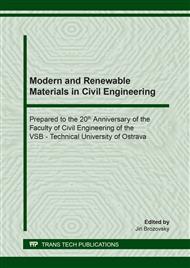[1]
Boulekbache B., Hamrat M., Chemrouk M., Amziane S.: Flowability of fibre-reinforced concrete and its effect on the mechanical properties of the material. Construction and Building Materials 24 (2010), p.1664–1671.
DOI: 10.1016/j.conbuildmat.2010.02.025
Google Scholar
[2]
Barragán B., Zerbino R., Gettu R., Soriano M., De la Cruz C., Giaccio G., Bravo M.: Development and application of steel fibre reinforced self-compacting concrete. 6th RILEM Symposium on Fibre Reinforced Concrete FRC – BEFIB, Varenna, Italy, (2004), p.457–466.
DOI: 10.1007/978-3-030-58482-5_17
Google Scholar
[3]
Ding Y., Thomaseth D., Niederegger Ch., Thomas A., Lukas W.: The investigation on the workability and flexural toughness of fibre cocktail reinforced self-compacting high performance concrete. BEFIB, Varenna, Italy, (2004), p.467–478.
DOI: 10.1016/j.conbuildmat.2007.11.006
Google Scholar
[4]
Zerbino R., Tobes J.M., Bossio M.E., Giaccio G.: On the orientation of fibres in structural members fabricated with self compacting fibre reinforced concrete. Cement & Concrete Composites 34, (2012), p.191–200.
DOI: 10.1016/j.cemconcomp.2011.09.005
Google Scholar
[5]
Kim DJ, Naaman AE, El-Tawil S.: Comparative flexural behavior of four fiber reinforced cementitious composites. Cement & Concrete Composites 30, (2008), p.917–928.
DOI: 10.1016/j.cemconcomp.2008.08.002
Google Scholar
[6]
Ding Y., Azevedo C., Aguiar J.B., Jalali S.: Study on residual behavior and flexural toughness of fibre cocktail reinforced self compacting high performance concrete after exposure to high temperature. Construction and Building Materials 26, (2012), p.21–31.
DOI: 10.1016/j.conbuildmat.2011.04.058
Google Scholar
[7]
Ding Y., Liu S., Zhang Y., Thomas A.: The investigation on the workability of fibre cocktail reinforced self-compacting high performance concrete. Construction and Building Materials 22, (2008), p.1462–1470.
DOI: 10.1016/j.conbuildmat.2007.03.034
Google Scholar
[8]
Kang S.-T., Kim J.-K.: Investigation on the flexural behavior of UHPCC considering the effect of fiber orientation distribution. Construction and Build. Mat. 28, (2011), p.57–65.
DOI: 10.1016/j.conbuildmat.2011.07.003
Google Scholar
[9]
Ponikiewski T., Cygan G.: Some properties of self-compacting concretes reinforced with steel fibres. Cement Wapno Beton, 78, (2011), p.203–209.
Google Scholar
[10]
Kang S.-T., Kim J.-K.: The relation between fiber orientation and tensile behavior in an Ultra High Performance Fiber Reinforced Cementitious Composites (UHPFRCC). Cement & Concrete Research 41, (2011), p.1001–1014.
DOI: 10.1016/j.cemconres.2011.05.009
Google Scholar
[11]
Tanikella P.N.D., Gettu R.: On the distribution of fibers in self compacting concrete. 7th RILEM Symposium on Fibre - Reinforced Concretes - BEFIB, RILEM Publications S.A.R.L Chennai, India., (2008), p.1147–1153.
DOI: 10.1007/978-3-030-83719-8_17
Google Scholar
[12]
Tattersall, G H, Banfill, P F G.: The Rheology of Fresh Concrete. Boston, Pitman Books Limited, (1983).
Google Scholar
[13]
EN 12350-8:2009 Testing fresh concrete, Part 8: Self-compacting concrete — Slump-flow test.
DOI: 10.3403/30210219
Google Scholar
[14]
Domski J., Katzer J., Zakrzewski M., Ponikiewski T.: Comparison of the mechanical characteristics of engineered and waste steel fiber used as reinforcement for concrete, Journal of Cleaner Production, vol. 158 (2017), 18-28.
DOI: 10.1016/j.jclepro.2017.04.165
Google Scholar


